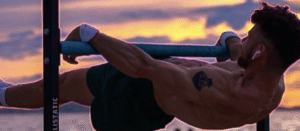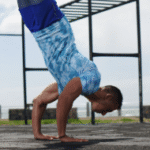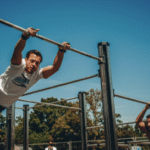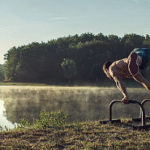The Ultimate Calisthenics Glossary for Houston Athletes
Calisthenics, or bodyweight fitness, utilizes specific terminology to describe movement patterns, skill progressions, and core body positions. Understanding this glossary is essential for any Houston athlete—from beginners training at Memorial Park to advanced practitioners at a specialized gym—to communicate effectively, follow a program safely, and master the science of progressive overload.
- Foundational Movements and Concepts
These are the building blocks of every calisthenics routine.
Term Definition and Importance Progression/Application
Compound Movement Any exercise that engages multiple joints and muscle groups simultaneously (e.g., Pull-up, Squat). Crucial for building functional strength and maximizing muscle-building stimulus.
Progressive Overload The principle of continually increasing the demand on the muscles to force adaptation and growth. Achieved by increasing reps/sets , slowing the tempo , or changing the leverage (e.g., moving from incline to flat push-up).
Relative Strength Your strength in proportion to your body weight. The ultimate measure of fitness in calisthenics; high relative strength is key for advanced skills.
Time Under Tension (TUT) The total amount of time a muscle is actively engaged during a set. Maximized by slowing the eccentric phase (the lowering part) of the movement, which accelerates hypertrophy.
Regression An easier variation of an exercise used to safely build foundational strength (e.g., Australian Pull-up as a regression for a full Pull-up). Essential for beginners to prevent injury and maintain perfect form.
- Essential Body Positions and Holds
Mastering these isometric holds is the foundation for all static and dynamic calisthenics skills.
Term Description and Core Function Importance for Calisthenics Skills
Hollow Body A foundational core position achieved by lying on your back, pressing the entire lower back into the floor, lifting the arms and straight legs slightly. The anti-extension posture required for a straight Handstand, Planche, and maintaining a rigid core during a Pull-up.
Plank Holding a straight, rigid body line supported by the hands or forearms. Builds core rigidity and shoulder stabilization; key for all pushing movements.
Scapular Retraction/Protraction The movement of the shoulder blades. Retraction (squeezing them together) is key for Rows and Pull-ups . Protraction (pushing them apart) is key for Push-ups and Planches . Essential for shoulder health and preventing impingement in overhead movements.
L-Sit Holding the body upright between parallel bars or rings with straight legs extended horizontally, forming an ‘L’ shape. A high-level test of core compression and lower abdominal strength.
Front/Back Lever Static Holds where the body is held rigid and horizontal. Front Lever is chest-to-bar; Back Lever is facing the floor. Advanced skills that demonstrate complete core-to-back integration and shoulder strength.
III. Upper Body Skills and Movements
Term Definition Progression Focus
Eccentric Phase The lowering (negative) phase of a lift (e.g., lowering down from a Pull-up). Most important phase for hypertrophy. Should be done slowly (3–5 seconds) to maximize TUT.
Muscle-Up An explosive movement that transitions from a pull-up (pulling phase) to a dip (pushing phase) above the bar. Requires high explosive strength and mastering the False Grip (gripping with the wrist over the bar).
Australian Pull-up An inverted row performed under a low bar with feet on the ground. A regression for the full Pull-up, allowing beginners to build back and bicep strength safely.
Parallettes Low parallel bars used for handstands, L-sits, and push-up variations. Reduces wrist strain and allows for a greater range of motion in push-ups and dips.
- Vertical Skills and Balance
Term Definition Training Application
Handstand Balancing the body upside down with a rigid, straight line. Shoulder stability, balance, and core control. The Hollow Body is essential here.
Pike Push-Up A push-up performed with the hips elevated high (forming a V-shape) and the head moving vertically towards the ground. A regression for the Handstand Push-up, building vertical pressing strength for the shoulders.
Belly-to-Wall Handstand The safest handstand hold, performed with the belly facing the wall. Teaches the perfect straight-line posture ( Hollow Body ) and builds shoulder endurance without relying on balance.
- Houston Training Tips
Rigs (The Apparatus): Refers to the dedicated steel pull-up and dip bar structures found in parks like Memorial Park and Hermann Park .
The Heat Index: A crucial safety factor in Houston. Always prioritize perfect form in the morning and reserve high-volume, sweaty circuits for air-conditioned indoor gyms to prevent heat exhaustion.
Spotting: Since many calisthenics skills involve balance and height, utilizing the local community for safe spotting is vital.

The Ultimate Calisthenics Glossary for Houston Athletes
Route
Calisthenics Gym Houston Functional Bodyweight Training
Secondary phone: (346) 483-3195
Email: info@calisthenicsclubhouston.com
URL: https://calisthenicsclubhouston.com/
Monday 6:00 AM - 7:00 PM Tuesday 6:00 AM - 7:00 PM Wednesday 6:00 AM - 7:00 PM Thursday 6:00 AM - 7:00 PM Friday 12:00 PM - 6:30 PM Saturday 9:45 AM - 12:00 PM Sunday 3:00 PM - 5:00 PM





